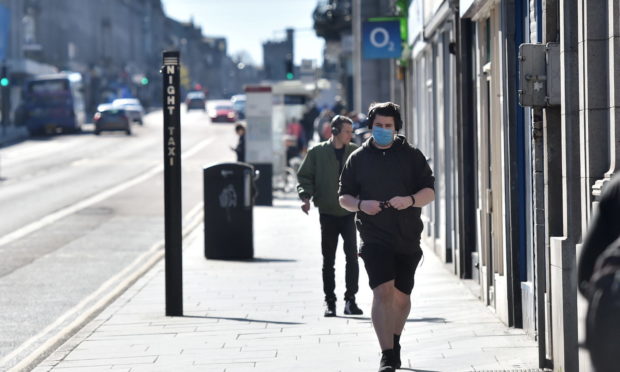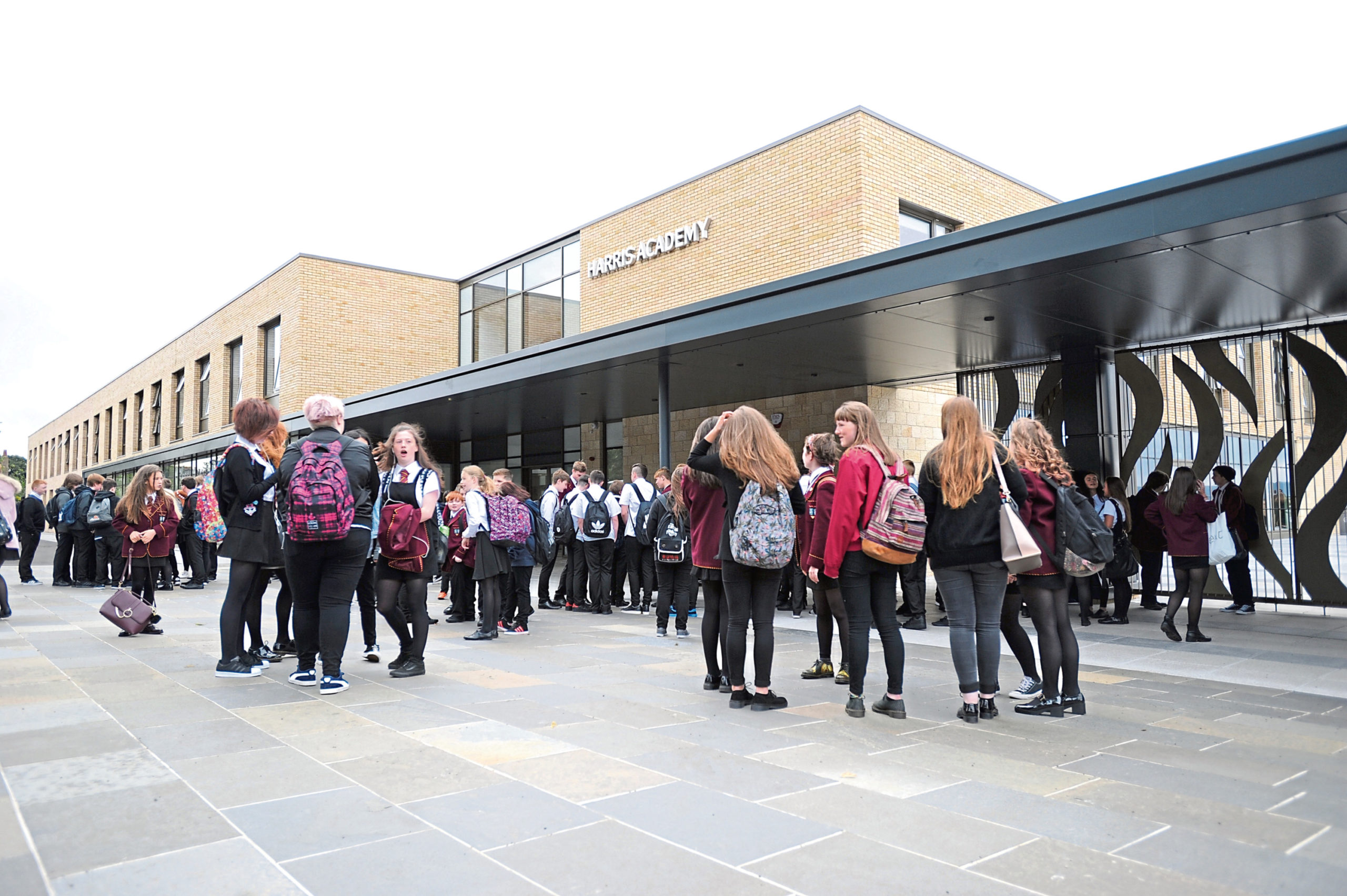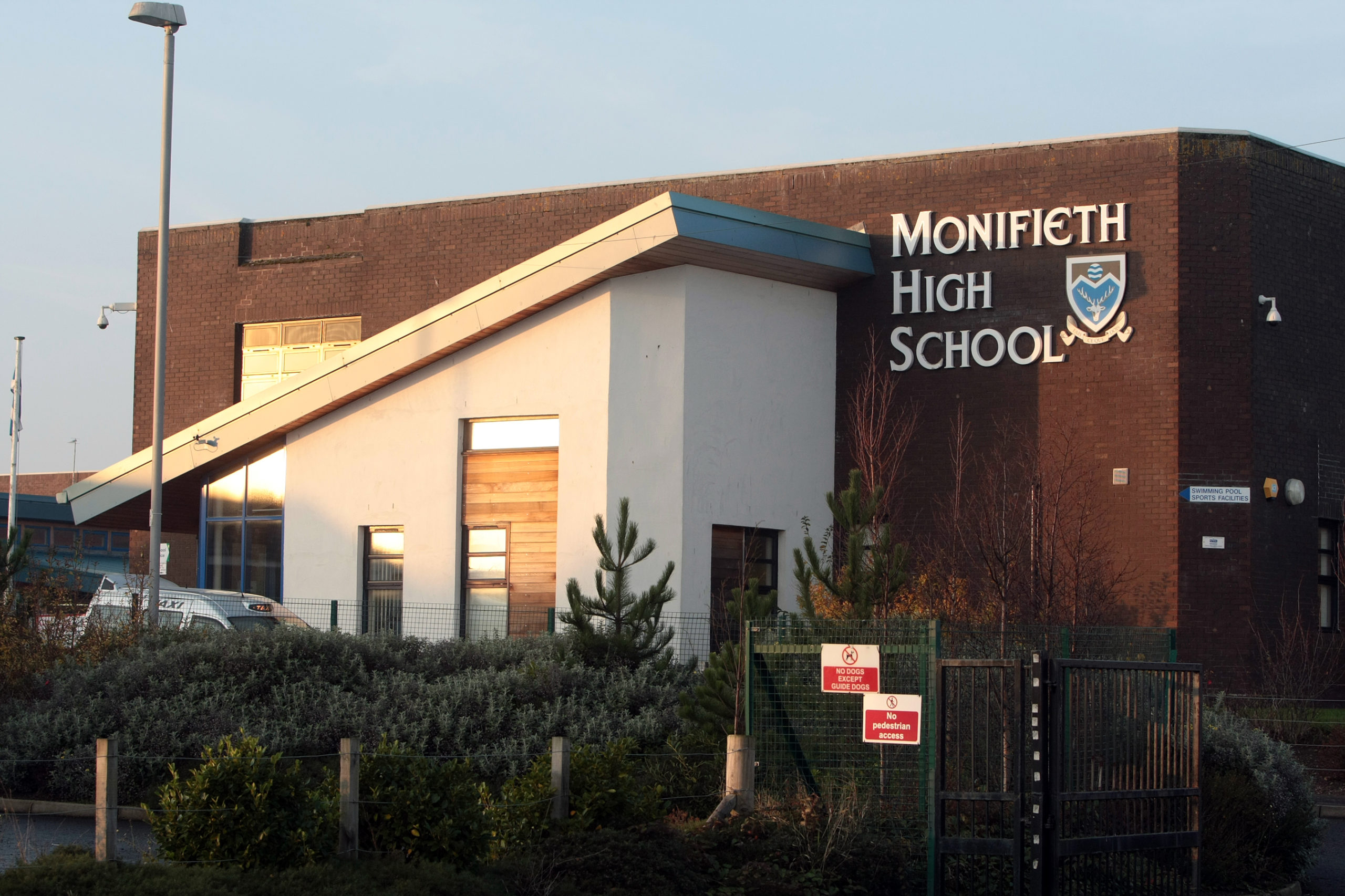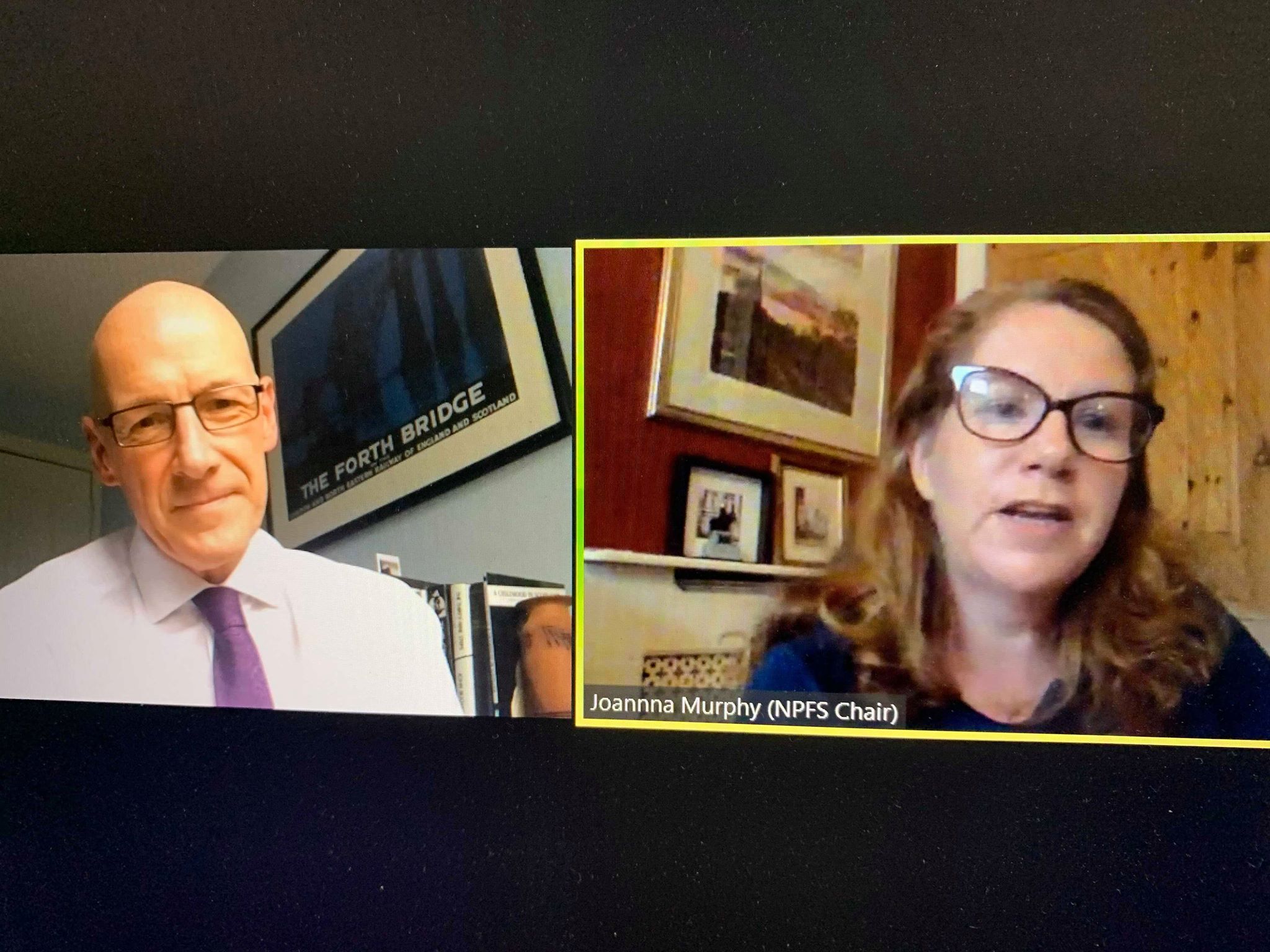More than a fifth of secondary schools in Tayside and Fife were at near or above capacity during the last school year.
Scottish Government figures show that of September 2019, 11 of the 45 secondary schools across Tayside and Fife were more than 90% full.
Of these 11, six were at 95% capacity or above.
Fife had the most secondary schools close to capacity or full, with four of the 19 in region at 95% capacity or above.
This has prompted concerns about the ability to maintain social distancing, particularly in secondary schools where the Scottish Government recommends that it is encouraged among pupils where possible.
Dundee
The figures show that nine of Dundee’s 43 schools were at 95% capacity or above in September 2019.
Harris Academy, which only opened in 2016, was 99% full with 1,290 on its school roll.
And a freedom of information (FOI) request submitted to Dundee City Council has show the school has now reached its capacity, with provisional figures of 1,315 pupils in this academic year.
Grove Academy – which has had one confirmed case of Covid-19 since pupils returned – was 92% full in September last year.
But pupil numbers at the Ferry secondary are also expected to rise, with the roll for this academic year 1,305, close to 50 more than last year.
In September 2019, St John’s High School pupil roll meant that it was 85% full. However, the provisional roll of 1,315 at the start of this academic year means the school is now at 90% capacity.
The Scottish Government data also shows that four of Dundee’s primary schools were full or over capacity when pupil numbers were recorded in September 2019.
Blackness and Ss Peter and Paul’s primary schools were at 112% and 107% capacity respectively, whilst Rosebank and Craigowl were also full.
It should be noted that provisional school rolls show that both Blackness and Ss Peter and Paul’s have reduced their pupil count, although they remain over capacity.
The council continues to work closely with colleagues from the trade unions and Tayside Contracts to provide a safe environment for everyone who works in our schools.”
Dundee City Council spokesman
The Scottish Government did not provide figures for Kingspark School but Dundee City Council’s own reports show the special school was at 108% in September 2019. Numbers there are expected to fall by two this year to 184 pupils currently enrolled.
A spokesman for Dundee City Council said: “Issues like capacities were looked at carefully by schools ahead of the return of pupils. A range of measures has been put in place including hand sanitising facilities and the staggering of breaks and lunchtimes to ensure the safety of all pupils and staff.
“We strictly adhere to national guidelines and have been pleased with the response of secondary pupils to changes around the wearing face coverings.
“Advice is being given regularly to our young people to stress how important their actions are to prevent the transmission of coronavirus.
“Officers from children and families services have liaised with specialist public health staff from NHS Tayside to deal with any cases involving pupils and staff and we are looking to implement lessons learned for all our schools
“The council continues to work closely with colleagues from the trade unions and Tayside Contracts to provide a safe environment for everyone who works in our schools.”
Angus
Official school rolls taken in September 2019 show that four primary schools and one secondary school in Angus were at 95% or above capacity.
Monifieth High School had 1,119 pupils enrolled at the start of the last academic year, 59 more more than its planned capacity.
This number is expected to rise and provisional rolls for this year provided by Angus Council show that the school currently has 1,131 pupils, an increase of 12.
The second most populated school is Forfar Academy, which is at 87% capacity based on the provisional numbers. This is followed by Arbroath High School at 81% and Carnoustie High School at 80% respectively.
Montrose Academy is the least full, with the provisional pupil roll amounting to just 65% of the school estate.
Woodlands Primary School, Carnoustie, was eight pupils above its working capacity last year. This was followed by Warddykes and Mattocks primary schools which were at 97.8% and 97.3% capacity respectively.
Whitehills Primary School was 95% full.
There have been no confirmed coronavirus cases relating to schools in Angus since pupils returned last month.
A spokeswoman for Angus Council said: “A small number of Angus schools currently have their maximum intake capped to allow us to manage rolls down.
“All of our schools have robust systems in place to ensure children and young people can safely attend school. Schools are making use of all available spaces for learning and teaching, including outdoors where appropriate.
“School leadership teams ensure buildings are risk assessed and have measures in place to comply with national guidance from the Scottish Government and Health Protection Scotland.”
Perth and Kinross
Figures released by the Scottish Government show that as of September 2019, there were no secondary schools in Perth and Kinross over capacity.
Perth High School had an official roll of 1,456, meaning it was at 94% capacity. Provisional school rolls provided by the local authority show that the school roll is up by more than 70 this term, meaning the school is now 99% full.
Bertha Park High School, which opened earlier this year, was at just 18% capacity but its number shows a provisional increase to 346 pupils, up more than 100 since the first roll was registered.
The primary schools with the highest percentage of their capacity filled in the region were Newhill Primary School in Blairgowrie – which has had one case of Covid-19 since pupils returned – and St Dominic’s RC Primary.
Both these schools are full.
Oakbank Primary, which has also had a confirmed case of the virus, was 93% full as of September 2019.
A Perth and Kinross Council spokesman said: “Nothing is more important than the safety of our pupils and staff and Perth and Kinross Council has introduced a range of measures across our schools to minimise the spread of coronavirus.
“All national health guidance is being followed and each head teacher has completed a risk assessment for their individual school to limit the risk of transmission. Each school will manage the situation differently depending on its size and capacity and has worked with trade unions on their plans.
“Measures adopted including staggered entry times, plans for moving around school buildings, clear arrangements for the sharing of equipment and additional cleaning.
“All pupils are encouraged to wash their hands regularly and hand sanitiser is also provided.
“Additionally, secondary school pupils and staff are asked to follow Scottish Government guidance on wearing face coverings when moving around communal areas.
“Schools also have robust procedures in place for when a pupil of staff members tests positive for Covid-19, which sees all their close contacts asked to self-isolate for 14 days.”
Fife
Last year’s data shows that four of the 18 secondary schools across Fife were 95% or above capacity.
Auchmuty High School, Balwearie High School and Viewforth High School were all full, whilst Woodmill High School in Dunfermline was at 96.4% capacity.
Queen Anne High School, which has had one confirmed case of Covid-19 since pupils returned last month, was at 82.5% capacity as of September 2019.
The 2019 data also shows that 12 primary schools in the Fife region were either full or over capacity, with the pupil roll at Duloch Schools and Community Campus 67 pupils over the campus capacity.
This was closely followed by Wormit Primary School and Hill of Beath Primary School which were at 114% and 113% capacity respectively.
Fife Council have been approached for comment.
There are “always concerns”
The Scottish Government figures have raised concerns about the ability of pupils to socially distance whilst at school.
Joanna Murphy, chair of the National Parent Forum of Scotland, said: “Some schools are significantly over capacity. At the moment this makes it difficult to implement any social distancing at all in some schools, which is of concern.
“There were suggestions when we were going to be doing blended learning to start using other facilities outside of the school estates, such as local halls and libraries that are still not being used for anything else.
“I think before the government moves to anything else more extreme that it would be more helpful to look at this to space young people out.
“They stopped looking at this because we were all going back to school and everything was fine but actually it’s not fine and it’s showing it’s not fine.
“Parents are always concerned about the state of school estates, lots of schools are not in great overall repair. We accept now that we are moving into a period of financial hardship for local authorities but if the pandemic showed anything it was that schools are more than places where young people learn but are significant for development socially for young people.”
However, others are keen for this not be used as an “excuse” to shut schools again in the event of a positive case.
Jo Bisset, organiser for UsForThem Scotland, said: “The return to school for children across Scotland of all ages should be as normal as possible. If we stick to that approach, the issue of schools being near capacity won’t matter.
At the moment this makes it difficult to implement any social distancing at all in some schools, which is of concern.”
Joanna Murphy, chair of the National Parent Forum of Scotland
“We cannot have a situation where the government or councils use this as an excuse to close schools down or revert to the widely-criticised blended learning approach.
“That would be incredibly detrimental to wellbeing of our pupils and their future prospects.
“Children have suffered enough through this pandemic. It’s up to the authorities to find a solution that will not impact on their learning.”



